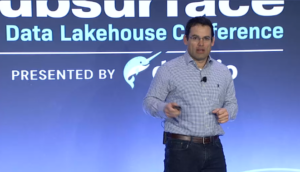[ad_1]

(vladwel/Shutterstock)
Information professionals with plans to construct lakehouses atop the Apache Iceberg desk format have two new Iceberg providers to select from, together with one from Tabular, the corporate based by Iceberg’s co-creator, and one other from Dremio, the question engine developer that’s holding its Subsurface 2023 convention this week.
Apache Iceberg has emerged as one of many core applied sciences upon which to construct an information lakehouse, during which the scalability and flexibity of knowledge lakes is merged with the information governance, predictability, and correct SQL habits related to conventional knowledge warehouses.
Initially created by engineers at Netflix and Apple to cope with knowledge consistency points in Hadoop clusters, amongst different issues, Iceberg is rising as a defacto knowledge storage commonplace for open knowledge lakehouses that work with all analytics engines, together with open supply choices like Trino, Presto, Dremio, Spark, and Flink, in addition to business choices from Snowflake, Starburst, Google Cloud, and AWS.
Ryan Blue, who co-created Iceberg whereas at Netflix, based Tabular in 2021 to construct a cloud storage service across the Iceberg core. Tabular has been in a personal beta for some time now, however right this moment the corporate introduced that it’s now open for enterprise with its Iceberg service.
In response to Blue, the brand new Tabular service principally works as a common desk retailer working in AWS. “It manages Iceberg tables in a buyer’s S3 bucket and means that you can join up any of the compute engines that you just wish to use with that knowledge,” he says. “It comes with the catalog you want to monitor what tables and metadata are there, and it comes with built-in RBAC safety and entry controls.”
Along with bulk and streaming knowledge load choices, Tabular offers automated administration duties for sustaining the lakehouse going ahead, together with compaction. In response to Blue, Tabular’s compaction routines can shrink the scale of shoppers’ Parquet recordsdata by as much as 50%.
“Iceberg was the inspiration for all of this and now we’re simply constructing on high of that basis,” says Blue, a Datanami 2022 Particular person to Watch. “It’s a matter of having the ability to detect that somebody wrote 1,000 small recordsdata and clear them up for them in the event that they’re utilizing our compaction service, slightly than counting on folks, knowledge engineers specifically, who’re anticipated to not write a thousand small recordsdata right into a desk, or not write pipelines which can be wasteful.”
Tabular constructed its personal metastore, generally known as a catalog, which is important for monitoring the metadata utilized by the assorted underlying compute engines. Tabular’s metastore is predicated on a distributed database engine, and scales higher than the Apache Hive metastore, Blue says. “We’re additionally focusing on rather a lot higher options than what’s offered by the Hive metastore or wire-compatible Hive metastores like Glue,” he says.
Tabular’s service may even shield in opposition to the ramifications of by accident dropping a desk from the lakehouse. “It’s very easy to be within the improper database, to drop a desk, after which understand, uh oh, I’m going to interrupt a manufacturing pipeline with what I simply did!” Blue says. “How do I shortly go and restore that? Effectively, there is no such thing as a manner in Hive metastore to shortly restore a desk that you just’ve dropped . What we’ve carried out is we’ve constructed a technique to simply preserve monitor of dropped tables and clear then up… That manner, you may go and undrop a desk.”
Blue, who spoke right this moment throughout Dremio’s Subsurface event and timed the launch of Tabular to the occasion, describes Tabular as the underside half of an information warehouse. Customers get to resolve for themselves what analytical engine or engines they use to populate the higher half of the warehouse, or lakehouse.
“We’re purposefully going after the storage facet of the information warehouse slightly than the compute facet, as a result of there’s a variety of nice compute engines on the market. There’s Trino, Snowflake, Spark, Dremio, Cloudera’s suite of instruments. There’s a variety of issues which can be good at varied items of this. We would like all of these to have the ability to interoperate with one central repository of tables that make up your analytical knowledge units. We don’t wish to present any a type of. And we truly suppose it’s vital that we separate the compute from the storage on the vendor stage.”
Customers can get began with the Tabular service free of charge, and are free to make use of it till the 1TB restrict is hit. Blue says that ought to give testers sufficient time to familiarize themselves with the service, see the way it works with their knowledge, and “fall in love” with the product. “As much as 1TB we’re managing free of charge,” he says. “When you get there now we have base, skilled, and enterprise plans.”
Tabular is obtainable solely on AWS right this moment. For extra info see www.tabular.io and Blue’s weblog submit from right this moment.
Dremio Discusses Arctic
In the meantime, Dremio can be embracing Iceberg as a core element of its knowledge stack, and right this moment throughout the first day of its Subsurface 2023 convention, it mentioned a brand new Iceberg-based providing dubbed Dremio Arctic.
Arctic is an information storage providing from Dremio that’s constructed atop Iceberg and accessible on AWS. The providing brings its personal metadata catalog that may work with an array of analytic engines, together with Dremio, Spark, and Presto, amongst others, together with automated routines for cleansing up, or “vacuuming” Iceberg tables.
Arctic additionally offers fine-grained entry management and knowledge governance, in accordance with Tomer Shiran, Dremio’s founder and chief product officer.
“You may see precisely who modified what, in what desk and when, all the way down to the extent of what SQL command has modified this desk within the final week,” Shiran says, “or was there a Spark job and what’s the ID that modified the information. and you’ll see all of the historical past of each single desk within the system.”
Arctic additionally allows one other function that Dremio calls “knowledge as code.” Simply as Git is used to handle supply code for pc applications and allow customers to simply roll again to earlier variations, Iceberg (through Arctic) can allow knowledge professionals to work extra simply with knowledge.
Shiran says he’s very excited in regards to the potential for knowledge as code inside Arctic. He says there are a number of apparent use instances for treating knowledge as code, together with guaranteeing the standard of ETL pipelines through the use of “branching;” enabling experimentation by knowledge scientists and analysts; delivering reproducibility for knowledge science fashions; recovering from errors; and troubleshooting.
“At Dremio, by way of our product and expertise, we’ve labored very laborious to make Apache Iceberg straightforward,” Shiran says. “You don’t actually need to know any of the expertise.”
Subsurface 2023 continues on Thursday, March 2. Registration is free at www.dremio.com/subsurface/stay/winter2023.
Associated Gadgets:
Open Desk Codecs Sq. Off in Lakehouse Information Smackdown
Snowflake, AWS Heat As much as Apache Iceberg
Apache Iceberg: The Hub of an Rising Information Service Ecosystem?
[ad_2]

